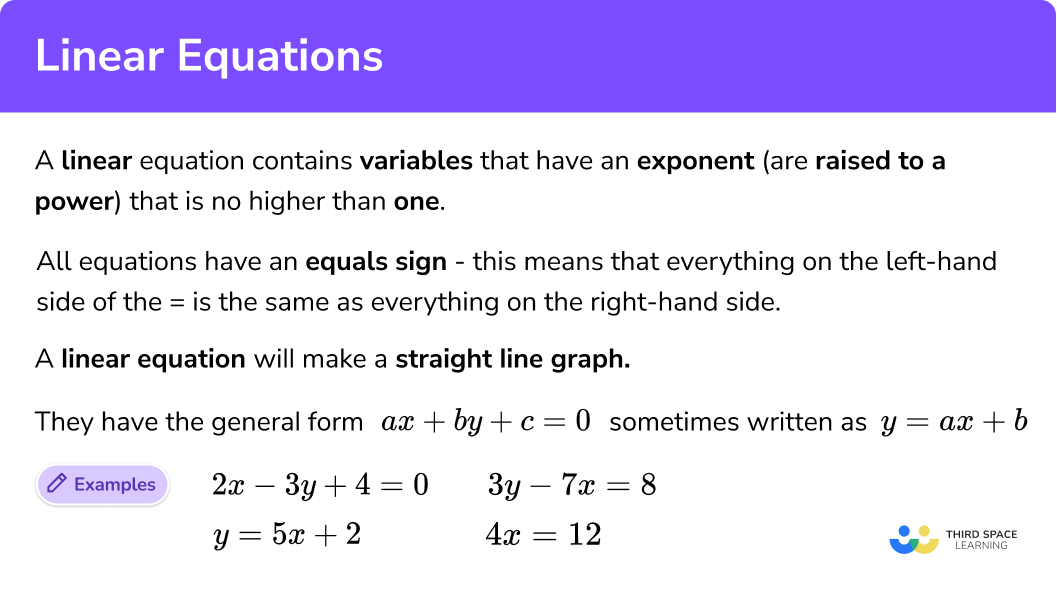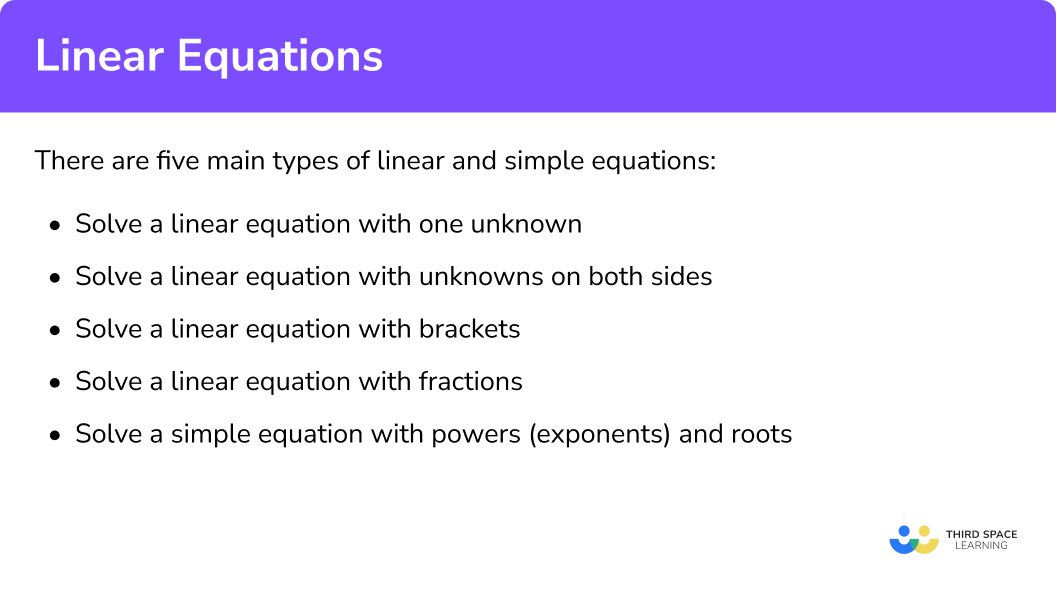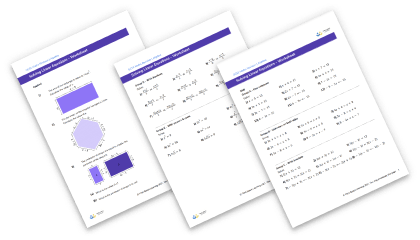GCSE Tutoring Programme
Our chosen students improved 1.19 of a grade on average - 0.45 more than those who didn't have the tutoring.
In order to access this I need to be confident with:
Factorising Expanding brackets Simplifying expressionsThis topic is relevant for:

Linear Equations
Here we will learn how to solve linear and simple equations, including equations with one unknown, equations with an unknown on both sides, equations with brackets and equations with fractions.
There are also solving linear equations worksheets based on Edexcel, AQA and OCR exam questions, along with further guidance on where to go next if you’re still stuck.
What is a linear equation?
A linear equation is an equation that contains variables that have an exponent (are raised to a power) that is no higher than one.
All equations have an equals sign, which means that everything on the left-hand side of the = is exactly the same as everything on the right-hand side.
A linear equation will make a straight line graph and have a general form of
This is often written as
For example,
What are linear equations?

How to solve linear equations and simple equations
We solve a linear equation by combining like terms and simplifying.
There are five main types of linear and simple equations:
a Solve linear equations with one unknown
b Solve linear equations with an unknown on both sides
c Solve linear equations with brackets
d Solve linear equations with fractions
e Solve simple equations with powers (exponents) and roots
In order to solve a linear equation or a simple equation we need to work out the value of the unknown variable by doing the opposite of what the operation tells us to do.
Top tip:
Leave the variable alone for as long as possible and deal with everything else first.
- If the equation has an addition, to ‘undo it’ we need to use subtraction
- If the equation has a subtraction, to ‘undo it’ we need to use addition
- If the equation has a multiplication, to ‘undo it’ we need to use division
- If the equation has a division, to ‘undo it’ we need to use multiplication
We can check that our answer is correct by substituting it back into the original equation.
What are the 5 main types of linear and simple equations?


Linear equations worksheet

Get your free linear equations worksheet of 20+ questions and answers. Includes reasoning and applied questions.
DOWNLOAD FREE
Linear equations worksheet

Get your free linear equations worksheet of 20+ questions and answers. Includes reasoning and applied questions.
DOWNLOAD FREERelated lessons on solving equations
Linear equations is part of our series of lessons to support revision on solving equations. You may find it helpful to start with the main solving equations lesson for a summary of what to expect, or use the step by step guides below for further detail on individual topics. Other lessons in this series include:
a) Solve linear equations with one unknown
In order to solve linear equations with one unknown:
- Rearrange the equation so the unknown variable is on its own on one side
- Work out the unknown variable by doing the opposite of what it says
Example with two steps
To solve
we need to:
1 Rearrange the equation so the unknown variable
Here the opposite of
2 Work out what the unknown variable
Here
so we divide by
We can check that our solution is correct by substituting it into the original equation
Fully worked out answer:
b) Solve linear equations with an unknown on both sides
In order to solve linear equations with an unknown on both sides:
- Rearrange the equation so the unknown variables are on the same side
- Rearrange the equation so the unknown variable is on its own on one side
- Work out what the unknown variable
(x) is by doing the opposite of what it says
Example with an unknown on both sides
To solve
we need to:
1 Rearrange the equation so the unknown variables
Here
2 Rearrange the equation so the unknown variable
3 Work out what the unknown variable
Here
so we divide by
We can check that our solution is correct by substituting it into the original equation
Fully worked out answer:
c) Solve linear equations with brackets
In order to solve linear equations with brackets:
- Expand the brackets
- Solve the equation by rearranging to get the unknown variable by itself on one side and then doing the opposite of what it says.
Example with brackets
To solve
we need to:
1 Expand the brackets
2 Solve the equation by rearranging to get the unknown variable
Here the opposite of
Then
so we divide by
We can check that our solution is correct by substituting it into the original equation.
Top Tip:
We could have first divided both sides of the equation by 4 for this question as 4 is a factor of 12.
Fully worked out answer:
d) Solve linear equations with fractions
In order to solve linear equations with fractions:
- Multiply each fraction by the denominator on the other side of the = to get rid of the fractions; don’t forget to include brackets.
- Expand the brackets
- Rearrange the equation so the unknown variables are on the same side.
- Solve the equation by rearranging to get the unknown variable by itself on one side and then do the opposite of what it says.
Example with fractions
To solve
we need to:
1 Multiply each fraction by the denominator on the other side of the = to get rid of the fractions; don’t forget to include brackets.
2 Expand the bracket
3 Rearrange the equation so the unknown variables
Here
4 Solve the equation by rearranging to get the unknown variable
We can check that our solution is correct by substituting it into the original equation.
Fully worked out answer:
e) Solve simple equations with powers and roots
In order to solve simple equations with powers and roots:
- Rearrange the equation so the unknown variable is on its own on one side
- Work out the unknown variable by doing the opposite of what it says
Example with a power
To solve
we need to:
1 Rearrange to get the unknown variable
Here
so we divide by
2 Work out the unknown variable by doing the opposite of what it says.
The opposite of squaring is to take the square root, so do this to both sides.
(Remember square roots have a positive and a negative answer)
Fully worked out answer:
Example with a square root
To solve
we need to:
1 Rearrange to get the unknown variable
Here
so we divide by
2 Work out the unknown variable by doing the opposite of what it says.
The opposite of taking the square root is squaring, so do this to both sides.
We can check that our solution is correct by substituting it into the original equation.
Fully worked out answer:
Common misconceptions
- We must do the opposite of what the operation tells us to do
E.g.
means
The opposite of
E.g.
means
The opposite of
- We must do the same thing to both sides of the equal sign
Equals means that both sides of the
E.g.
If we
- When cross multiplying we must use brackets to multiply every term in the numerator
We only multiply the numerator, not the denominator.
E.g.
- When expanding brackets we need to multiply out each term
E.g.
Be careful when multiplying the coefficients
- Remember a polynomial is an algebraic expression that consists of two or more algebraic terms
Practice linear equations questions
1. Solve:
2x+8=20
x=14

x=8

x=6

x=10

Subtract 8 from both sides
2x=12
Divide both sides by 2
x=6
2. Solve:
5x-3=12
x=5

x=-8

x=3

x=-12

5x-3=12
Add 3 to both sides
5x=15
Divide both sides by 5
x=3
3. Solve:
2x-7=x+5
x=7

x=12

x=-7

x=4

2x-7=x+5
Subtract x from both sides
x-7=5
Add 7 to both sides
x=12
4. Solve:
7x-3=4x+15
x=4

x=7

x=6

x=3

7x-3=4x+15
Subtract 4x from both sides
3x-3=15
Add 3 to both sides
3x=18
Divide both sides by 3
x=6
5. Solve:
5(x-3)=10
x=2

x=3

x=5

x=-3

5(x-3)=10
Divide both sides by 5
x-3=2
Add 3 to both sides
x=5
6. Solve:
3(x-3)=6(x+5)
x=3

x=-5

x=-13

x=13

3(x-3)=6(x+5)
Expand the brackets
3x-9=6x+30
Subtract 3x from both sides
-9=3x+30
Subtract 30 from both sides
-39=3x
Divide both sides by 3
x=-13
7. Solve:
\frac{x+3}{2}=\frac{x+4}{3}
x=-3

x=-4

x=-2

x=-1

\frac{x+3}{2}=\frac{x+4}{3}
Multiply both sides by 6 and simplify
3x+9=2x+8
From both sides, subtract 2x and subtract 9
x=-1
8. Solve:
\frac{3x+1}{2}=\frac{2x-2}{4}
x=-2

x=2

x=-1

x=1

\frac{3x+1}{2}=\frac{2x-2}{4}
Multiply the both sides by 4 and simplify
6x+2=2x-2
From both sides, subtract 2x and subtract 2
x=-1
9. Solve:
16{x}^2=64
x=\pm4

x=\pm2

x=\pm3

x=\pm16

16{x}^2=64
Divide both sides by 16
x^{2}=4
Square root both sides
x=\pm2
10. Solve:
5\sqrt{3x}=30
x=36

x=3

x=12

x=9

5\sqrt{3x}=30
Divide both sides by 5
\sqrt{3x}=6
Square both sides
3x=36
Divide both sides by 3
x=12
Linear equations GCSE questions
1. Solve:
3 x^{2} = 27
(1 mark)
x=\pm 3
(1)
2. Solve:
4(3 – x) = 32
(2 marks)
12 – 4x = 32 or 3 – x = 8
(1)
x = -5
(1)
3. Solve:
\frac{2x + 3}{5}=\frac{x – 5}{2}
(3 marks)
2(2x + 3) = 5(x – 5)
(1)
4x + 6 = 5x – 25
(1)
x=31
(1)
Learning checklist
You have now learned how to:
-
Use algebraic methods to solve linear equations.
The next lessons are:
Still stuck?
Prepare your KS4 students for maths GCSEs success with Third Space Learning. Weekly online one to one GCSE maths revision lessons delivered by expert maths tutors.

Find out more about our GCSE maths tuition programme.